Questions:
- Does the bottleneck metric require both persistence diagrams have the same number of points?
- Answer: Unmatched points are projected down to the diagonal line. If we take into account the diagonal line, there is always the same number of points.
- The persistence modules work over a field . The given example is homology groups over a field. Can this be done with homology groups over a group like or ?
- Answer: Typically we work over a finite field .
- How do persistence diagrams differ for persistence modules?
- Is it possible to construct an -interleaving?
- Answer: It would be very difficult. Typically work with existence results.
- What exactly is -tame modules?
- Proposition 3.3
Full paper can be found at: https://link.springer.com/article/10.1007/s10711-013-9937-z
A brief summary can be found at: 2024-09-06
Introduction
Given a metric space which “approximates” another metric space , our goal is construct a simplicial complex on the vertex set such that the homology or homotopy type is the same as . In most applications, is finite.
One common approach is simply the Vietoris-Rips complex:
For a closed Riemannian manifold , the geometric realization of is homotopy equivalent for sufficiently small . More generally, if is “sufficiently close” (see daily note 2024-04-16 on Gromov-Hausdorff distance) to , there is some such that is homotopy equivalent to .
In summary, we can recover the underlying topology of from a sufficiently close approximation . Unfortunately, finding the correct as described above depends on the underlying geometry. We can circumnavigate this issue by using persistence of the filtration . It was shown by Chazal et al. that for finite metric spaces
where is the bottleneck metric on persistence diagrams and is the Gromov-Hausdorff distance.
One immediate consequence of this result is that instead of working with the more messy Gromov-Hausdorff distance, we can use the bottleneck metric which is easier to compute.
Persistence modules and persistence diagrams
We define a persistence module over as an indexed family of vector spaces with a family of linear maps which satisfy whenever .
Example: Let be a filtered simplicial complex, that is, whenever . Let be the homology groups (coefficients from a field ) and be induced by inclusion . Then is a persistence module.
Given two persistence modules and over and , we define a homomorphism of degree as a collection of linear maps
such that whenever . In other words, the following diagram commutes.
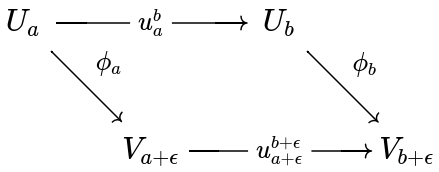
We denote the set of such homomorphisms by .
Example continued: Given , if is a map between simplicial complexes such that for any , then induces a homomorphism between persistence modules and .
For , an important -degree endomorphism is the shift map given by the maps . One may see that for any we get that for all . That is, for all indices and the diagram below commutes:
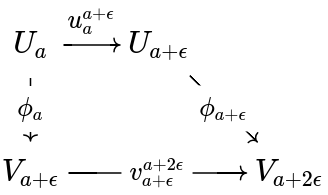
Two persistence modules are -interleaved if there are homomorphisms and such that and . So for all indices , the diagrams below commute:

Furthermore, a persistence module is -tame if whenever .
Theorem 2.3
If is a -tame module then it has a well-defined persistence diagram . If are -tame persistence modules that are -interleaved then there exists an -matching between the multisets , . Thus, the bottleneck distance between them satisfies the bound .
In short, if two -tame persistence modules are -interleaved then their bottleneck distance is less than . Since gives a lower-bound to the twice the Gromov-Hausdorff distance, -interleaved can be used to show two spaces are sufficiently close.
Multivalued maps
\epsilon-simplicialLet and be two filtered simplicial complexes with vertex sets and respectively. A map is -simplicial if it induces a simplicial map for every . That is, for all simplices , we get as a simplex.
The paper provides an unnecessarily complex definition of a multivalued map between and as a subset of such that the projection is surjective. Ultimately, the only difference is that a single may be mapped to multiple .
A single-valued map is subordinate to a multivalued map if for all and is denoted .
\epsilon-simplicialLet and be two filtered simplicial complexes with vertex sets and . A multivalued map is -simplicial if for any and any simplex , every finite subset of is a simplex of .
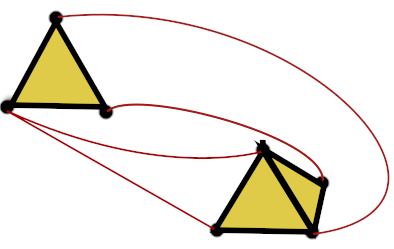
Proposition 3.3
If is an -simplicial multivalued map, then induces a canonical linear map equal to for any .
Here represents the homomorphism of degree between and induced by (I think…). The proposition states that given any multivalued map that maps simplices in to simplices in , there is a homomorphism of degree between and . Moreover, it states that it is given by any subordinate map which implies that all subordinate maps induce the same homomorphism of degree . Thus, any subset of , also gives the same map, i.e., for any multivalued map .
Proposition 3.5
Let be filtered complexes with vertex sets . If
- is -simplicial
- is -simplicial
then is -simplicial and .
Correspondences
Correspondence
A multivalued map is a correspondence if the projection is surjective, i.e., for every there is at least one such that . Alternatively, the transpose (constructed by image of map) is a multivalued map.
If is a correspondence then the maps and satisfy
Let be a correspondence between vertex sets of filtered complexes and . If maps simplices to simplices and maps simplices to simplices , then and induce -interleaved persistence modules and .

Proposition 4.2
Let , be filtered complexes with vertex sets , . If is a correspondence such that and are both -simplicial, then they induce a -interleaving between and , namely and .
Proposition 4.2 and Theorem 2.3 lay out a foundation for proving an upper bound on the bottleneck distance. That is, showing the filtered complexes are -tame and there is a correspondence such that and are -simplicial.
Consider the case where and are metric spaces. Then a correspondence has distortion defined by
We can us the distortion to calculate the Gromov-Hausdorff distance:
“low-distrortion” correspondences give rise to -simplicial maps.
Vietoris-Rips and Cech complex
Let be a metric space. We get a filtered simplicial complex where
Lemma 4.3
Let and be metric spaces. For any the persistence modules and are -interleaved.
Since there is a correspondence with distortion at most . Consider and finite subset . Notice that for any , there is some such that and . Then
But by the reverse-triangle inequality,
So . Thus, is an -simplicial from to . A similar argument holds for .
The paper proves a similar result for the Cech complex.
Dowker Complexes
The Cech complex discussed in class is known as the “intrinsic Cech complex” and is constructed from a single metric space. A common approach in TDA is to use a pair or triple of metric spaces. These are examples of a more general class known as Dowker Complex.
Let and be subsets representing ‘landmarks’ and ‘witnesses’ of a metric space. For the ambient Cech complex has vertices and simplices given by
Letting gives a filtered complex .
This varies from the intrinsic Cech complex by only including -simplices if the intersection of the -balls include a witness point. One may see that the intrinsic Cech complex is simply the ambient Cech complex with as the witness set.
Let and be sets and a function. For the Dowker complex has vertices and simplices given by
Likewise, letting gives a filtered complex . Notice that for a metric space , is the same as . Likewise, the ambient Cech complex is the same as where is the ambient space.
We compare two sets of data and with correspondences and and define their distortion by
Lemma 4.9
If and are correspondences and then the persistence modules and are -interleaved.
The proof is almost identical to the Vietrois-Rips interleaving.
Corollary 4.10
Let denote the Hausdorff distance between subsets of a metric space. For any the ambient Cech persistence modules and are -interleaved.
Witness Complex
The paper generalized the Witness Complex discussed in class from the Euclidean metric to an arbitrary function . Then for any , and , we say is an -witness for simplex if
Thus,
Clearly for . Thus, by inclusion maps we get a filtered simplicial complex .
Let and be two witness sets for with maps and . Then the distortion of a correspondence is given by
If , then and are -interleaved. The proof follows a similar pattern as for Vietoris-Rips.
Often with witness complexes, and come from an ambient metric space and (see class notes). In such a situation, if then the persistence modules and are -interleaved. This is a corollary of the previous result. The set
forms a correspondence with .
Remark: The above results do not apply when the two spaces have differing landmark sets.
Counterexample: Let and for some . Then
whereas
for all . Even though can be made arbitrarily small, the homology persistence modules do not -interleave when .
Regularity of Rips and Cech filtrations
A subset of a metric space is an -sample of if for any , there is some such that . In other words, every point in can be approximated by a point in . We say a metric space is totally bounded if it has a finite -sample for every . Alternatively is totally bounded if for every we can cover with finitely many balls. For example, a bounded subset in would be totally bounded.
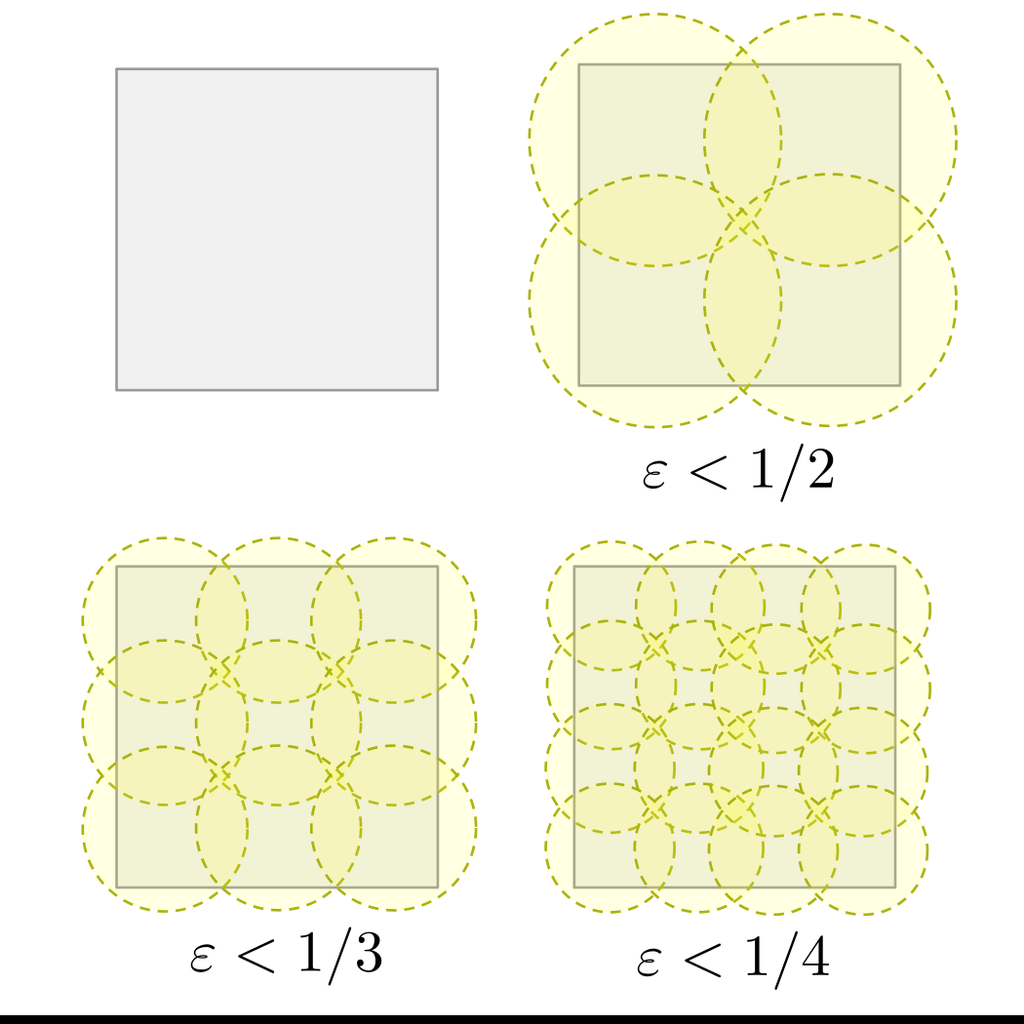
Proposition 5.1
If is a totally bounded metric space then the persistence modules and are -tame.
The proof constructs the correpondence: where is an sample of . Notice that for all ,
As a result, the Gromov-Hausdorff distance is less than and there is an -interleaving (Lemma 4.3). Letting results in the map in the persistence module factoring into
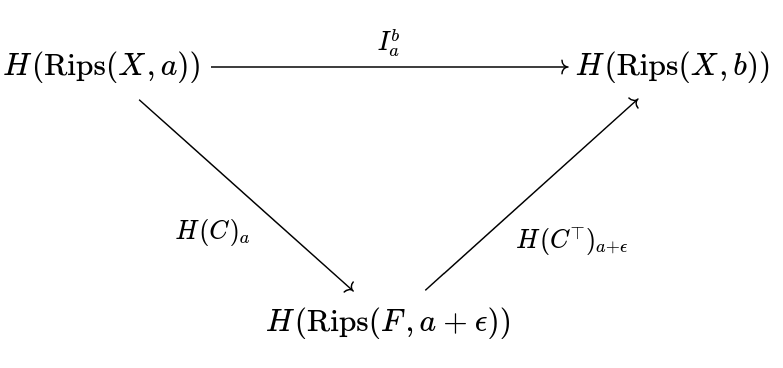 Since is finite-dimensional, is a finite simplicial complex. Therefore, has finite rank.
Since is finite-dimensional, is a finite simplicial complex. Therefore, has finite rank.
As a result the persistence diagrams of and are well-defined for totally bounded metric spaces.
Theorem 5.2
Let be totally bounded metric spaces. Then
and
Proof: Lemma 4.3, Proposition 5.1, and Theorem 2.3.
We get similar results for ambient Cech complexes:
Proposition 5.4
Let be subsets of a metric space. If at least one of is totally bounded, then the ambient Cech persistence is -tame.
The proof is similar to proposition 5.1. For every it shows that is -interleaved with a finite simplicial complex. Namely, where is an -sample with .
Theorem 5.6
Let and be subsets of a metric space. Suppose are totally bounded or that is totally bounded. Then
Finally for Dowker complexes:
Proposition 5.7
Let be sets and be a function. Suppose the collection of functions is bounded and totally bounded with respect to the supremum norm on functions . Then is -tame.
Again we show that is -interleaved with a persistent homology for a finite simplicial complex. Let be a finite subset of such that is an -sample of . Construct the following correspondences:
By Lemma 4.9, we get that and are -interleaved.
The homology groups of a Rips filtration
One may construct a homology group with uncountable infinite dimension.
Let
with the metric from . Notice that for any , the edge is in but no triangles contain in its boundary. Thus, for each , the cycles
form a linearly independent set in .

Here the filtration is only “bad” for a single radius (). The paper provides a construction with arbitrarily large “bad” radii.
Proposition 5.9
For any with and integer , there is a compact metric space such that for any the -homology has an uncountable infinite dimension.
The assumes and (why?) and begins with the case . It constructs the following space:
with the norm in .
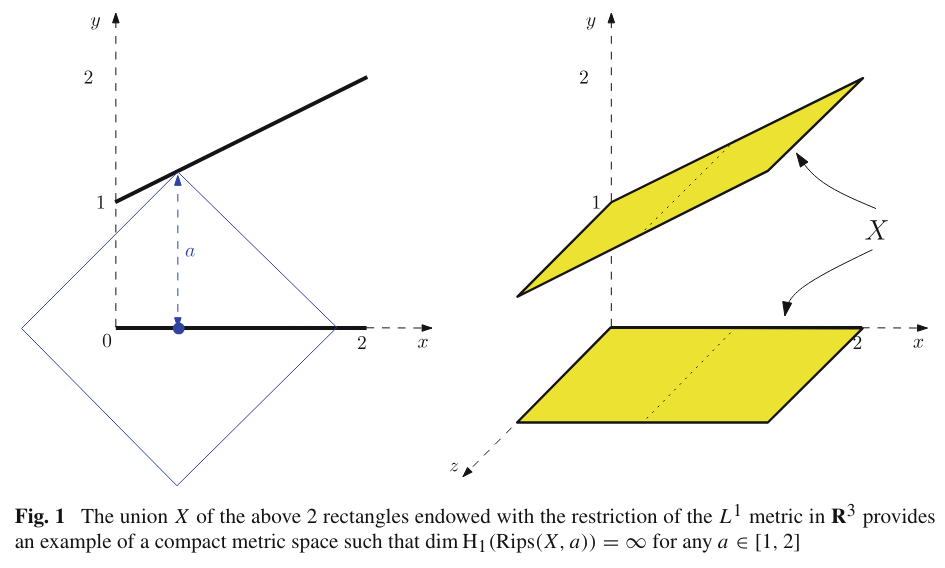
For and the edge is in but not contained in any non-degenerate triangle. Thus, for the cycles
are not homologous to 0 and linearly independent.
For , we take the product of with a -dimensional sphere with sufficiently large radius. It then follows by Künneth theorem:
The open Vietoris-Rips filtration
The Vietoris-Rips complex uses closed balls which was crucial to our “bad” constructions. We consider the open Vietoris-Rips complex made with open balls:
Under the open Vietoris-Rips complex the bad edge no longer exists. Under this construction we can ensure at least the homology is countable.
Proposition 5.10
For any totally bounded metric space and real number , the total homology has a countable basis.
Any cycle in is a finite linear combination of simplices with diameter less than . Thus, there is some such that their diameter is less than . Notice that such a class lives in the image of . By proposition 5.1, is -tame. So this image is finite dimensional. Moreover, is the union of all such images as . Since each image is finite, must have a countable basis.
However, we cannot guarantee finiteness.
Proposition 5.11
For any given there exists a totally bounded metric space such that has infinite dimension.
The first homology group of a Cech filtration
While the homology groups can be infinite dimensional for , the first homology group is better behaved.
Proposition 5.12
Let be a totally bounded metric space, and let . Then over any coefficient ring and any , is finitely generated over . In particular, if is a field then
Proof sketch:
- Every 1-cycle is homologous to a 1-cycle whose edges are at most length
- There is a finite set of edges with length at most such that for any edge of length at most , there is an edge in such that and .
- Any 1-cycle can be written in the form
- Any 1-cycle of the form with edges having length at most is homologous to cycle whose edges are in .
- Since every 1-cycle involves a finite set of edges , the first homology group is finitely generated.